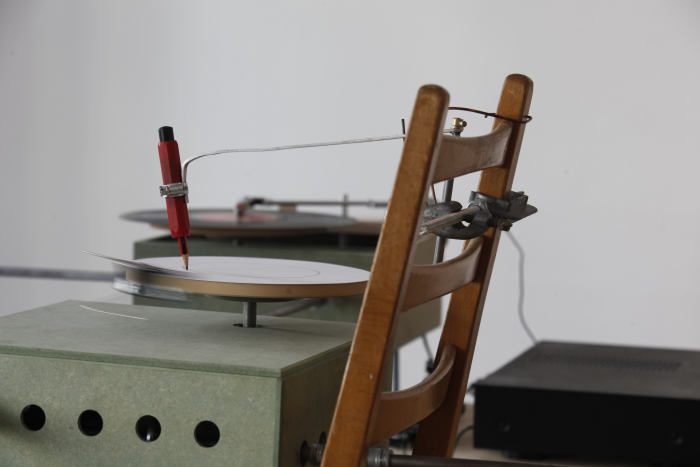Performing Machines
Using machines to produce artwork is an easy concept to grasp - since Andy Warhol’s Factory we are used to the idea of art as a commodity, and artist as facilitator, not necessary the single-handed producer. But what about when it is the machines that are the artwork, and no longer work to produce, but work as a performance. It is not the artist doing the physical work (or even their assistants) but the machine. In physics the concept of work can be interpreted as the measurement of the accomplishment of a task. To do work, effort (force) is required. However effort does not necessarily mean that work is done. The effort must accomplish something… a displacement must accompany the effort. But when a machine does not accomplish anything, as is the case in the examples I’m exploring, the act of working then becomes the work. There is no end commodity except work itself. With no end goal the ‘work’ is exposed.
Architect Helena Mattsson discusses this exposure of work in terms of the relationship between public space and work space. Work is turned into a commodity: “By introducing a public space into what is normally a closed structure, the organisation is opened up and the internal parts of its machinery are laid out for public inspection. This exhibitionistic display aestheticises everyday life, as well as work, by making it into entertainment”. In Manchester, our rich industrial heritage often seeps into our art. The once private cotton industry has become aesthetised by museums, and reinterpreted by artists. The cotton industry was famously dangerous and unethical; factories were tucked away, just outside cities, with the workers housed together, also hidden. By making machines perform, artists (like museums) are exposing the beauty of industry whilst also dismissing the pressure of production (a pressure felt by both factory workers and artists alike).
In this blog I have found examples of artworks that involve machines as artworks, working to no end other than to perform.
The Reversing Machine (A Theatre of Kairos and Chronos) 2012
Sam Belinfante and Simon Lewandowski
The Reversing Machine is a time-setting mechanism which can be connected up to different machines, acting as a drive shaft to power them to run forwards, then backwards. First shown at Art Laboratory Berlin at part of the exhibition ‘Fantastic Time Machines’ 2012, where it powered machines such as a turntable, a drawing machine and a slide projector. The work will be shown at the new Project Space Leeds (soon to be the ‘The Tetley') in December 2013, for which the artists are looking for musicians to submit palindromic or bi-directional compositions.


Almost Certified (grade A noise for non-discerning consumers) 2004
Kelli Cain and Brian Crabtree
This bizarre sound machine consists of a series of eggs of various unconventional varieties and sizes. The eggs are tapped by an aluminium mallet, and amplified. The process is operated by an obsolete 1993 Mac LC III. The piece was first displayed in 2004 at Machine Project Guide to Cultural History and the Natural Sciences, Pomona College Museum of Art, California.


Interesting blog article here
Physical Echoes 2013
James Medd
This drawing machine makes marks responding to real-time sound. It initially produces drawings that echo the ambience of whatever space the machine is in, but over time these drawings become a scribbled block as the pens move back and forth over the same space. The more the machines work, the less meaning their output has. First displayed at Digital Performance Lab at the University of Salford.

video:
Blog about the project here:
Homage to New York 1960
Jean Tinguely
Sometimes the most iconic artworks are the ones that fail. In 1960 Jean Tinguely undertook the hugely ambitious Homage to New York, a self-destructing artwork constructed in the sculpture garden of MOMA. The piece was enormous (27 ft wide and 23 ft high) and consisted of many intricate mechanical elements including a weather balloon which inflated until it burst, a painting machine, a player piano, a bottle smashing machine, and a recording of the artist explaining the work. It whirled, smoked, smashed and burned, performing for 27 minutes but failed to completely self-destruct.
Here's an excerpt from D.A. Pennebaker’s film documenting the event:
Audio lecture about Homage to New York here.
There's a Tinguely museum in Basel:
When Robots Rule : The Two Minute Airplane Factory 1999
Chris Burden
Another famous mechanical failure. The Two Minute Airplane Factory was on display in Tate Britain in 1999. The machine was supposed to make a paper airplane every two minutes, launching it 20 m high so that it circled the Duveen galleries, before gently coming to rest on the floor. The planes would then be for sale in the Tate shop. The machine failed to produce one paper airplane. The viewers, instead of watching the beautiful efficiency of a completely mechanised factory line, could watch the Tate gallery technicians trying in vain to get the machine to work. The only plane on display was the one made by Burden - by hand. Many think the mechanical failure was part of the piece; it may have never meant to be a performing machine, but rather performing management.

http://www.gagosian.com/artists/chris-burden-2
David Barrett article:



